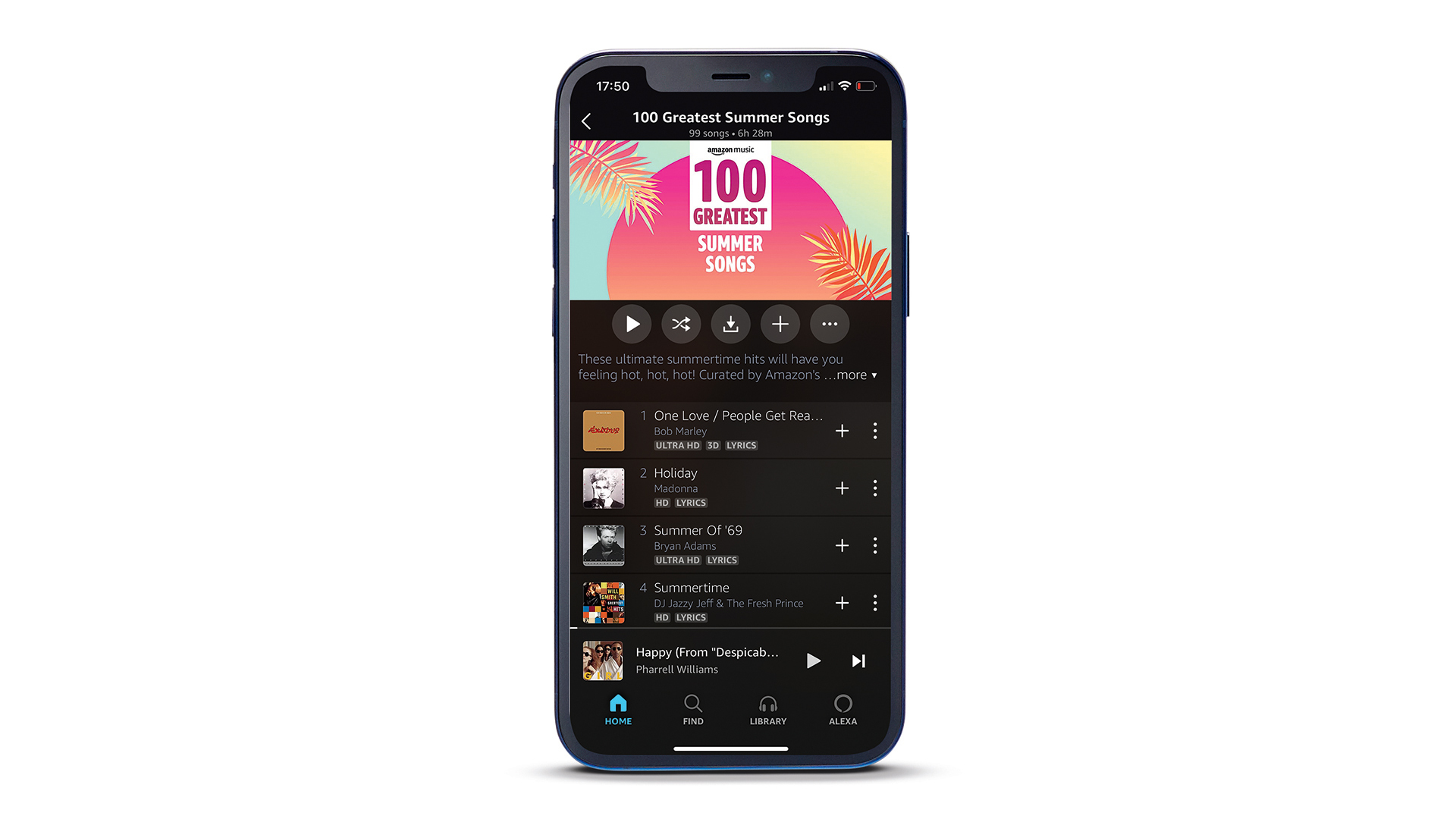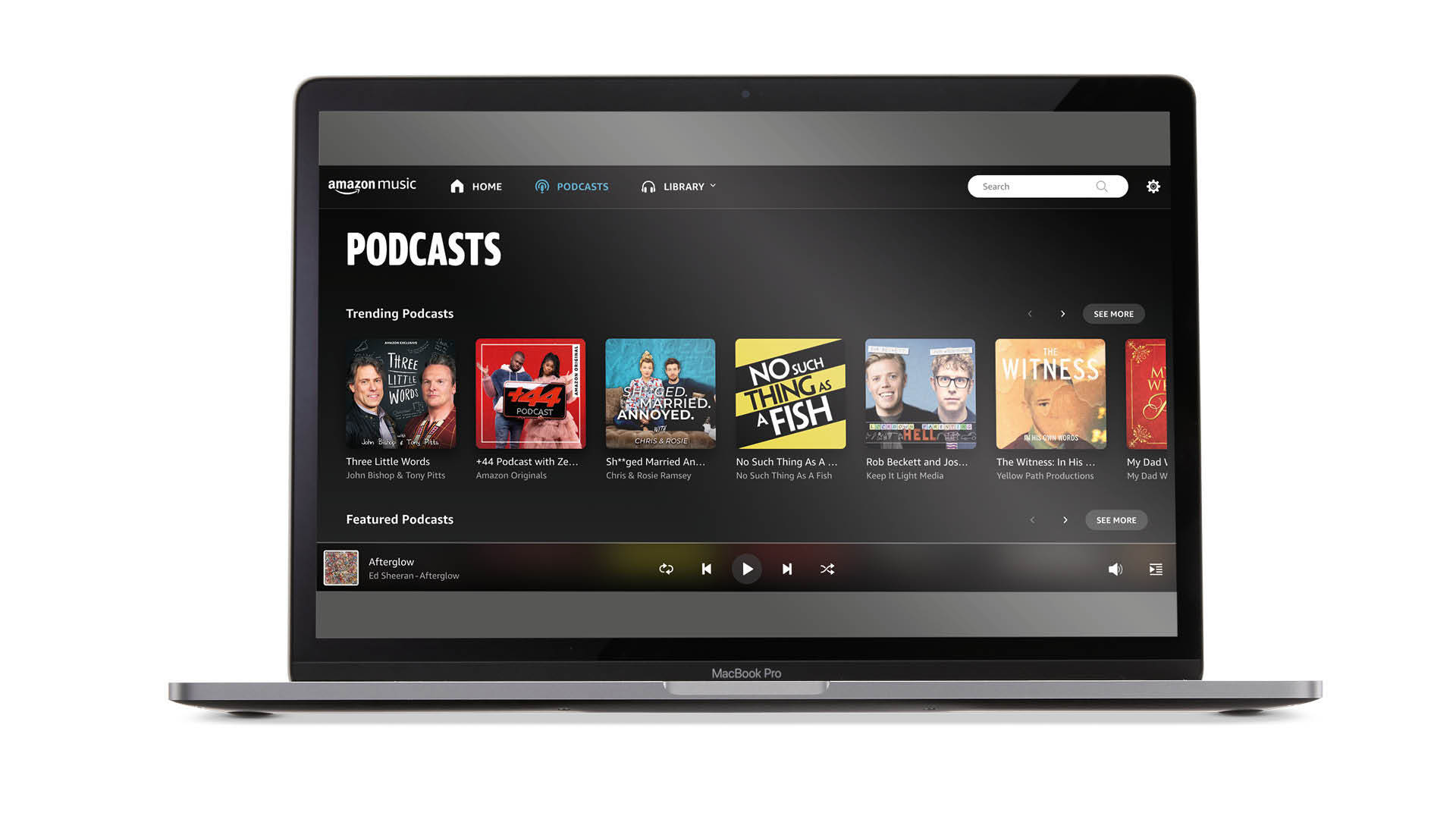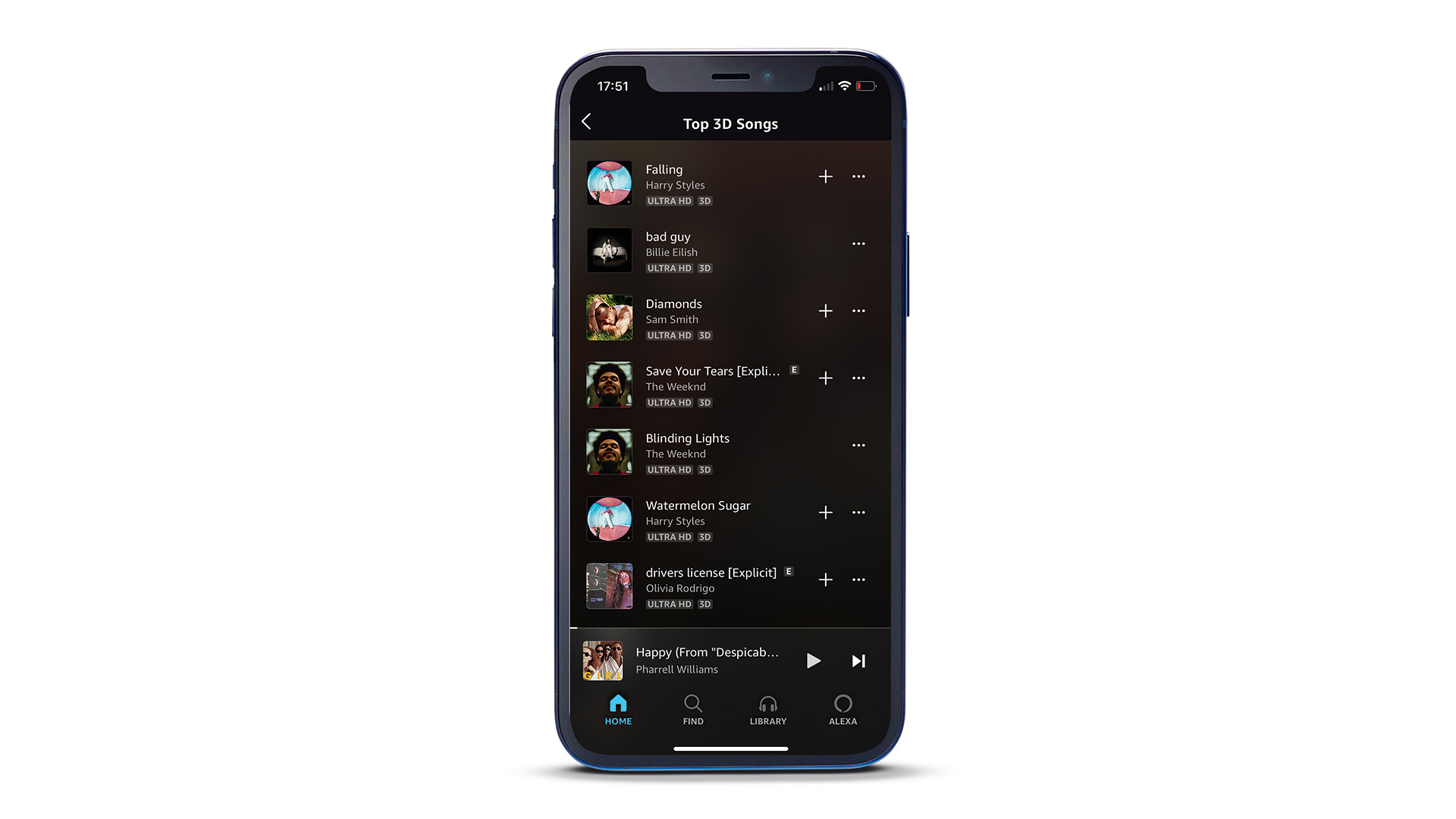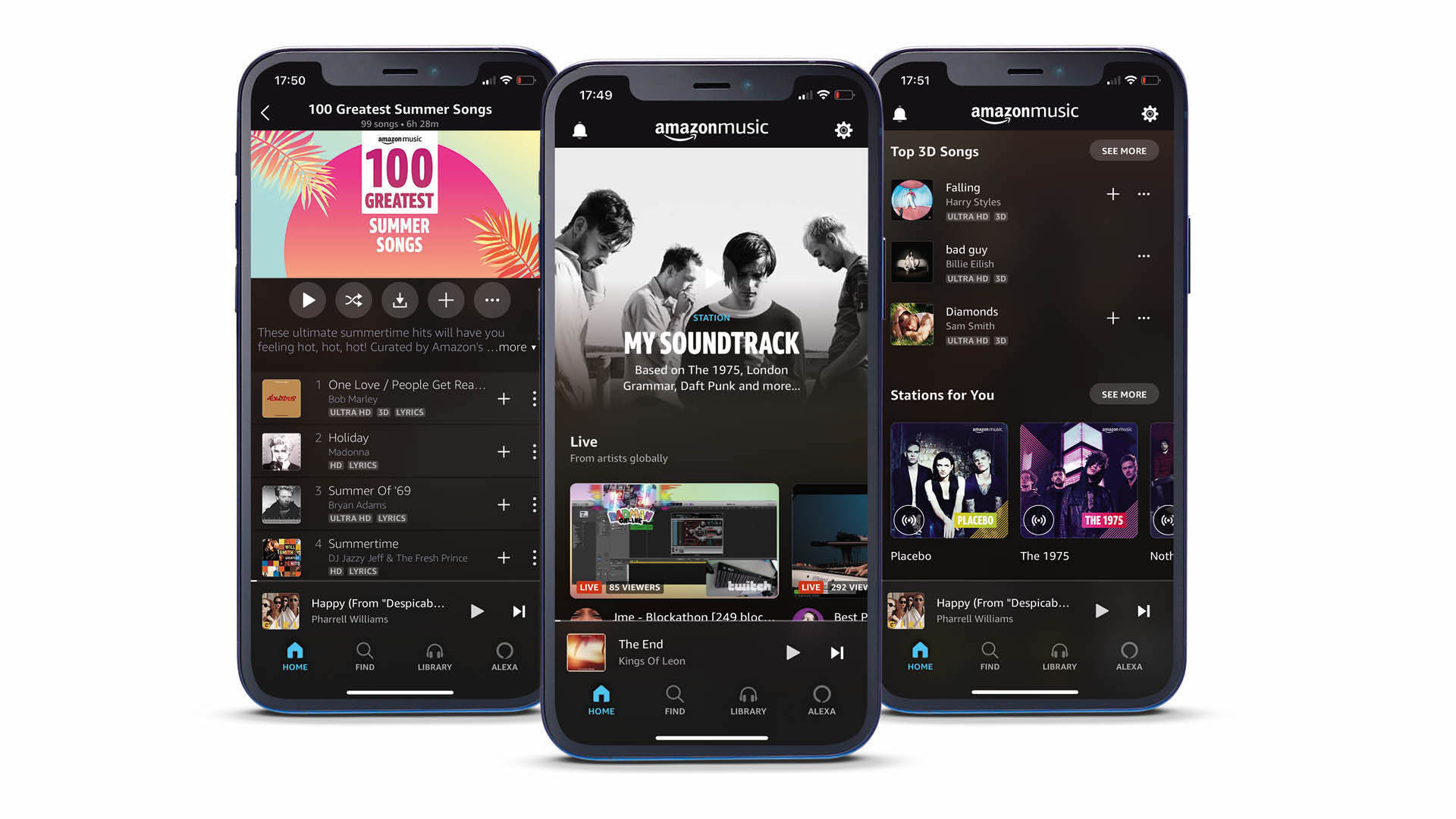What Hi-Fi? Verdict
A solid Spotify rival that will be particularly attractive for those in Amazon's fold
Pros
- +
Small discount for Prime subscribers
- +
Excellent catalogue
- +
HD and Ultra HD content is included…
- +
and sounds good
Cons
- -
Music discovery could be better
- -
Mobile app can be buggy
- -
User experience lacks a little cohesion
Why you can trust What Hi-Fi?
It’s easy to get confused with Amazon’s music streaming offerings. There is Amazon Music Free, Amazon Music Prime and what we are testing here: Amazon Music Unlimited.
Amazon Music Free gives you access to curated playlists and podcasts, while Amazon Music Prime offers greater access to playlists, limited access to a limited number of tracks and more playback options with no ads.
Amazon Music Unlimited has everything, from ‘open to all’ access to its 100m song catalogue (which includes CD-quality and hi-res) to podcasts, to curated playlists and much more. In theory, it is a very credible Spotify and Apple Music rival, but how does the much-travelled music-streaming service stack up in reality?
Price
Amazon's music streaming offering is split into Amazon Music Free, Amazon Music Prime and Amazon Music Unlimited.
Amazon Music free won't cost you a penny and will give you basic access to "thousands of stations and top playlists" and millions of podcasts.
Amazon Prime subscribers have access to Amazon Music Prime for free. This stripped-down version of Amazon Music Unlimited does give you ad-free access to Amazon's entire music catalogue but only in SD quality and you can only play via shuffling artists, albums, or playlists.
If you want to drill down into the catalogue or want to access higher-quality tracks, then you need Music Unlimited. Amazon regularly offers free trials that can run from 30 days to three months during some promotions, so potential subscribers can always try before they buy.
The latest hi-fi, home cinema and tech news, reviews, buying advice and deals, direct to your inbox.
Amazon Music Unlimited’s pricing structure has changed in recent months and years but not for the better.
Following an August 2023 price rise, it now costs £10.99/$10.99/AU$12.99 to subscribe to Amazon Music Unlimited without a Prime membership. With a membership, this drops to £9.99/$9.99 which is in line with the likes of Spotify and Apple Music. At the time of writing, it appears there is no discount for Prime subscribers in Australia.
Previously, Amazon Prime subscribers could make a small monthly saving on an Amazon Music Unlimited subscription that undercut rival services. However, that has been eroded and the incentive is no longer there.
In November 2022, the service’s family plan rose from £16.99/$15.99/AU$18.99 to £17.99/$16.99/AU$20.99. Alternatively, you can pay annually for £179/$169/AU$159.
There is also the option of signing up for a £5.99/$5.99/AU$6.99 per month tier that lets you use the service on a single Amazon Echo or Echo Dot wireless speaker.
An optional Amazon Music HD tier launched in 2019, giving you access to CD-quality and hi-res audio files, but these files are now included as part of the normal Amazon Music Unlimited subscription.
Compatibility

Amazon Music Unlimited is compatible with smartphones and tablets via its Android and iOS apps; PCs and Macs via either its web player or desktop app; Fire tablets and Fire TVs; some in-car entertainment systems; Sonos multi-room wireless speakers; Bluesound and NAD BluOS devices. It is worth noting that you can’t actually access CD-quality music or hi-res tracks in Amazon Music HD through your browser, though. This can be done only through the dedicated desktop and mobile apps, which is no bad thing.
Up to ten authorised devices can use Amazon Music on one account, although you can play through only one device at a time. Music can be downloaded to play offline on the iOS, Android and Fire tablet platforms.
Amazon Music Unlimited also works on its homegrown Echo and Dot wireless speakers, as does Spotify.
And Amazon has worked to further its service’s functionality, integration and intelligence with its voice-control assistant. For example, saying “Alexa, try Amazon Music Unlimited” gets you up and running with the service.
You can ask it to play certain songs, albums or artists (“Alexa, play Stormzy” will shuffle his songs) or, for example, 80s pop.
You can even search by lyrics; say “Alexa, play the song with the lyrics ‘hello, is it me you’re looking for?’” and it complies – even if it does choose a cover rather than Lionel Richie’s original. “What cover is this?” we ask. “Zooey Deschanel’s from the Trolls soundtrack” we are told. Like we didn't know.
The comprehension is spot-on. Just make sure you start each command with the wake word ‘Alexa’ (which can be changed).
Features

Amazon claims that more than 70 million songs are available on its service and the Music Unlimited home page points you to new releases, ‘popular’ and recommended music and playlists.
We don’t see any immediate gaps in its offering, and our search for more obscure music artists reveals a very good rate of success. After a slow start, the service has expanded its library of music videos too, although we wouldn’t call it extensive.
As with Prime Video, Music Unlimited gives you the option of purchasing through its Digital Store, which mirrors the ‘Digital Music’ section on Amazon’s website. Amazon scrapped its very useful Music Storage plans back in 2018.
Amazon Music Unlimited won’t look or feel alien to anyone who has ever used a streaming service, or a shopping website, come to that.
The dark interface has three main tabs: ‘Home’, ‘Podcasts’ and ‘Library’. Your ‘Home’ page is arranged in horizontal rows which showcase your most frequently played songs, playlists handpicked for you, songs you might like based on what you have been listening to and a range of playlists that relate to certain timely topics such as the ‘Sounds of Summer’.
There’s quite a lot going on and quite a lot of content to choose from, and there are slight differences between how the desktop and mobile apps prioritise and order recommended content and playlists which can make for a slightly disjointed user experience.
One of the key playlists you will use is My Discovery Mix, which is the equivalent of Discover Weekly on Spotify; a playlist of new tracks, it is created off the back of what you tend to listen to and your favourite tunes. We find it serves up enough new tracks to pique our interest, but it doesn’t have quite the success rate of Spotify, and the recommendations tend to be a little older too.

As you navigate your way around, you will spot songs labelled HD and some songs and playlists labelled Ultra HD. Confusingly, Amazon Music Unlimited doesn’t use the term HD when it is referring to high-resolution audio. Where you see tracks labelled HD, this actually means that they are CD-quality.
Amazon refers to and labels hi-res music as Ultra HD, (Ultra High Definition). Why? Presumably, it feels that this labelling will prove clearer for a mass audience – and perhaps it's right.
Amazon refers to HD tracks as having a ”bit depth of 16-bits, a minimum sample rate of 44.1 kHz (also referred to as CD-quality), and an average bitrate of 850 kbps.” UHD tracks, on the other hand, “have a bit depth of 24-bits, sample rates ranging from 44.1 kHz up to 192 kHz, and an average bitrate of 3730 kbps.”
To Amazon’s credit, it pushes Ultra HD content extremely hard on the service with dedicated playlists and clear labelling, eg Best of Ultra HD, Ultra HD: New Arrivals, Ultra HD Hip-Hop and Ultra HD Jazz. It doesn’t take long to find a steady stream of UHD music to listen to.
Click on the bright yellow HD or Ultra HD logos that accompany each track (on either desktop or mobile) and you are shown the sample rate of what you are playing together with the playback capabilities of your machine. The desktop app will even prompt you to change the audio settings on your computer to take advantage of the improved audio quality. It’s a clever and thoughtful touch, especially if you want to connect an external DAC that can handle all the available sample rates natively and make the most of Amazon’s hi-res library.
If you own any Echo devices (2nd-gen and newer), Fire TVs and Fire Tablets, these all support HD audio quality. And, should you own an Amazon Echo Studio, you will also be able to access Amazon’s catalogue of 3D audio tracks (encoded in either Dolby Atmos or Sony 360 Reality Audio) through Amazon Music Unlimited.
There’s a huge amount of music in hi-res on Amazon Music Unlimited. Neither Amazon nor Tidal releases exact figures but Amazon claims "millions" and our experience suggests that Amazon has a larger catalogue of hi-res music to call upon. There were several occasions when we found an Ultra HD release on Amazon but couldn’t find it as a Masters track on Tidal.
Ease of use

Need inspiration? Amazon can provide plenty of suggestive guidance, even if rival services do have the edge when it comes to music discovery and curated recommendations.
The ‘Discover New Music’ section for example, is a gateway to brand new releases that can also be drilled down into by music genre. And it makes good use of its screen real estate: album artwork and playlist graphics are bright and colourful and there are shortcuts for adding tracks and playlists straight to your library and downloading them for offline listening.
The familiar three-dot ellipsis is a neat way to expand functionality, and is where you can buy songs or add them to specific playlists or play more tracks by similar artists.
The mobile app looks good on smartphones and tablets, but isn’t quite as intuitive as those provided by Apple or Spotify. It also seems more susceptible to bugs and glitches. We have had the app refusing to play ball with wireless headphones and actually severing a Bluetooth connection. It has also failed to download some tracks in their entirety, so you get to enjoy only a small portion of the track before it skips to the next song. A spot of tweaking here and there to bring it more into line with the desktop app would make the user experience feel more cohesive.
Sound

Amazon has been coy about revealing its standard streaming bitrate, claiming to support “multiple bitrates”, but we would bet our reference hi-fi system that it’s not dissimilar from Spotify’s 320kbps streams.
Listen to the two side by side through a budget pair of headphones connected to a smartphone or laptop, and differences are barely audible.
It takes an accomplished DAC/headphone combo, such as the Chord Hugo 2/Grado SR325e, to discern that Amazon has a slight edge.
It’s a touch better in terms of dynamic subtlety, and there’s a pleasantness to its rounder-sounding presentation. The oozing harmonica opening of Conor Oberst’s Mamah Borthwick (a Sketch) sounds slightly warmer and more delicately delivered.
Switch over to Unlimited's CD-quality and hi-res streams you’ll be pleased to know we find they sound clearer, more detailed and more dynamic than the standard-quality fare.
Play No Church in the Wild by Jay-Z and Kanye West in Ultra HD through the desktop app and a decent USB DAC and there is an impressive level of detail throughout the track. Bass is probing and powerful – there’s real texture to every note as the bassline punches its way along. Vocals are detailed, clear and expressive.
Listening to Charli XCX's 2099 in Ultra HD on Amazon versus the same track in Tidal Masters, the former sounds more open, more detailed and more interesting to listen to. Although TIdal makes a bit more of the rhythm of the track, it also sounds more compressed and less open and lively. It can really vary from track to track.
Verdict
Changes in the streaming landscape haven’t made things easy for Amazon Music Unlimited. Tidal has dropped in price and Apple Music is cheaper (if you don't have Amazon Prime) and introduced CD-quality and high-res streams for no extra cost. Add the fact that both offer excellent user experiences and great sound quality into the mix and Unlimited doesn’t quite have the attraction it once did.
But it remains a loveable, quirky streaming service that still sounds competitive and boasts good catalogue depth – we still recommend giving it a go, especially if you can get your hands on a free trial.
SCORES
- Sound 4
- Features 4
- Ease of use 4
MORE:
Hi-res music streaming services compared: which should you sign up for?
Amazon Music Unlimited vs Spotify: which is better?
Apple Music vs Spotify: which is the best streaming service?
Our pick of the best free music apps
What Hi-Fi?, founded in 1976, is the world's leading independent guide to buying and owning hi-fi and home entertainment products. Our comprehensive tests help you buy the very best for your money, with our advice sections giving you step-by-step information on how to get even more from your music and movies. Everything is tested by our dedicated team of in-house reviewers in our custom-built test rooms in London, Reading and Bath. Our coveted five-star rating and Awards are recognised all over the world as the ultimate seal of approval, so you can buy with absolute confidence.


